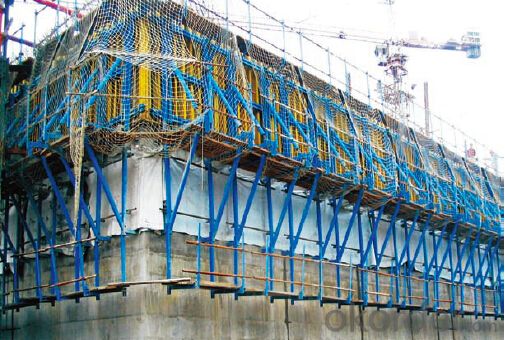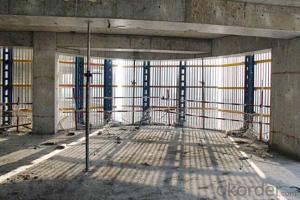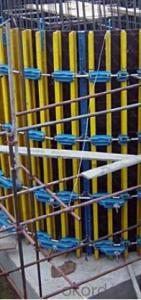Single-side Climbing Bracket SCB40 for formwork and scaffolding system
- Loading Port:
- Tianjin
- Payment Terms:
- TT OR LC
- Min Order Qty:
- 50 m²
- Supply Capability:
- 1000 m²/month
OKorder Service Pledge
OKorder Financial Service
You Might Also Like
Single-side Climbing Bracket SCB180:
With CNBM SCB 180 climbing systems, the loads from the fresh concrete pressure are
transferred through the brackets by means of V-strongbacks and compression braces into the
scaffold anchors.
Typical applications for the SCB 180 are dams, locks, cooling towers, pier heads, tunnels, and
bank vaults.
The formwork is simply tilted backwards when striking takes place. The 1.80 m wide bracket
requires only a minimum of space.
Characteristics:
◆ Economical and safe anchoring
The M30/D20 climbing cones have been designed especially for single-sided concreting using
SCB180 in dam construction, and to allow the transfer of high tensile and shear forces into the still
fresh, unreinforced concrete. Without wall-through tie-rods, finished concrete is perfect.
◆ Stable and cost-effective for high loads
generous bracket spacings allow large-area formwork units with optimal utilization of the bearing
capacity. This leads to extremely economical solutions.
◆ Simple and flexible planning
With SCB180 single-sided climbing formwork, circular structures can also be concreted without
undergoing any large planning process. Even use on inclined walls is feasible without any special
measures because additional concrete loads or lifting forces can be safely transferred into the
structure.


- Q: Can steel formwork be used for pier caps?
- Yes, steel formwork can be used for pier caps. Steel formwork is a versatile and durable material that can easily be customized to fit the specific dimensions and design requirements of pier caps. It provides a strong support system for concrete pouring and helps in achieving accurate and precise shapes for pier caps. Additionally, steel formwork offers the advantage of being reusable, making it a cost-effective choice for construction projects.
- Q: Is steel formwork suitable for projects with high formwork complexity?
- Yes, steel formwork is suitable for projects with high formwork complexity. Steel formwork offers high strength and durability, allowing it to withstand complex and intricate designs without compromising structural integrity. Additionally, steel formwork can be easily customized and adjusted to meet specific project requirements, making it an ideal choice for projects that demand complex formwork systems.
- Q: Are there any special considerations when using steel formwork in cold weather conditions?
- Special considerations should be taken into account when using steel formwork in cold weather conditions. Firstly, the cold temperatures can cause steel to contract and become more brittle, increasing the risk of cracks or fractures in the formwork. Therefore, it is important to ensure that the steel formwork is properly designed and reinforced to withstand the potential stress caused by temperature changes. Secondly, the curing process of concrete can be affected by the cold weather. Steel formwork tends to conduct heat away from the concrete, slowing down the curing process. This can result in insufficient strength development and compromise the structural integrity. To address this, additional measures may be necessary, such as using insulating materials or applying external heat sources to maintain optimal curing conditions. Furthermore, cold weather can lead to the formation of ice on the surface of the steel formwork due to moisture freezing. This can increase the weight of the formwork and make its removal difficult. Additionally, it can cause damage if not properly managed. Therefore, preventive measures must be taken, such as using anti-freeze agents or ensuring adequate drainage to prevent ice buildup. Lastly, working in cold weather conditions can pose challenges for construction workers. It is crucial to implement appropriate safety measures, including providing sufficient insulation, heating facilities, and protective clothing to prevent workers from experiencing hypothermia or other cold-related illnesses. In conclusion, when working with steel formwork in cold weather conditions, it is important to consider the increased risk of brittleness, the impact on concrete curing, the potential for ice formation, and the well-being of workers. By taking these special considerations into account, the use of steel formwork can still be efficient and effective in cold weather conditions.
- Q: What are the common challenges faced during steel formwork transportation?
- Some common challenges faced during steel formwork transportation include the heavy weight of the formwork, which may require specialized equipment and vehicles for transportation, potential damage to the formwork during loading and unloading, and the need for careful handling and securing to prevent accidents or injuries. Additionally, the size and shape of the formwork can present challenges in terms of fitting through narrow spaces or navigating tight corners during transportation.
- Q: What are the advantages of using modular steel formwork systems?
- There are several advantages of using modular steel formwork systems. Firstly, these systems are highly durable and can be reused multiple times, leading to cost savings in the long run. Secondly, they provide accurate and precise results, ensuring consistency in construction projects. Additionally, modular steel formwork systems offer flexibility and can be easily adjusted or customized to meet specific project requirements. They also enhance productivity as they can be quickly assembled and disassembled, saving time and labor. Moreover, these systems provide a smooth and high-quality finish to concrete structures. Overall, the advantages of using modular steel formwork systems include durability, cost-effectiveness, accuracy, flexibility, productivity, and superior finish.
- Q: Are there any disadvantages to using steel formwork?
- Yes, there are a few disadvantages to using steel formwork. Firstly, steel formwork is generally more expensive to purchase and maintain compared to other types of formwork materials. Additionally, steel formwork is heavier and more difficult to handle and transport, which can increase labor costs and project timelines. Furthermore, steel formwork requires skilled labor for assembly and dismantling, adding to the overall project costs. Lastly, steel formwork may not be suitable for all types of construction projects, especially those involving complex or irregular shapes.
- Q: How does steel formwork handle concrete segregation?
- Steel formwork is a popular choice in construction projects due to its strength and durability. When it comes to handling concrete segregation, steel formwork plays a crucial role in ensuring a homogeneous mixture and preventing the separation of coarse aggregates from the concrete matrix. Concrete segregation occurs when the different components of the concrete mixture, such as cement, water, aggregates, and admixtures, separate due to inadequate mixing or improper handling during placement. This can result in weak spots, reduced strength, and compromised structural integrity. Steel formwork helps prevent concrete segregation in several ways. Firstly, its rigid structure provides a stable and secure framework that holds the concrete in place during pouring and curing. This stability ensures that the concrete mixture remains intact and does not separate. Additionally, steel formwork can be designed with various features that help reduce segregation. For example, the formwork can be equipped with tie rods, clamps, or brackets to hold the form panels tightly together, preventing any movement or displacement of the concrete. These connections minimize the likelihood of aggregate separation and maintain a consistent mixture. Moreover, the smooth surface of steel formwork prevents excessive bleeding and settlement of the concrete, which are common causes of segregation. The lack of surface irregularities or absorbent properties minimizes the escape of water and cement paste, ensuring a more uniform distribution of aggregates within the concrete. Furthermore, steel formwork can be easily cleaned and maintained, preventing the accumulation of hardened concrete or debris that could lead to segregation issues. Regular cleaning and inspection of the formwork help ensure that the concrete is poured into a clean and well-maintained mold, reducing the chances of segregation. In conclusion, steel formwork is an effective solution for handling concrete segregation. Its rigid structure, secure connections, smooth surface, and easy maintenance all contribute to preventing the separation of aggregates from the concrete matrix. By utilizing steel formwork, construction projects can achieve a homogeneous and high-quality concrete placement, resulting in superior structural integrity and durability.
- Q: How does steel formwork affect the overall construction site aesthetics?
- The overall aesthetics of a construction site can be significantly impacted by the use of steel formwork. In contrast to traditional timber formwork, steel formwork offers a sleek and contemporary look. The smooth and pristine surfaces of steel formwork convey a sense of precision and professionalism to the construction site. Moreover, the utilization of steel formwork provides greater design flexibility. It can be effortlessly shaped and molded into intricate forms, resulting in visually appealing and one-of-a-kind structures. This flexibility empowers architects and designers to create innovative and captivating architectural elements that enhance the overall aesthetics of the construction site. Furthermore, steel formwork plays a role in maintaining the cleanliness of the construction site. Its durable and reusable nature minimizes waste generated during the construction process. This not only contributes to a cleaner and more organized site, but also reduces the environmental impact of the construction process. Additionally, steel formwork instills a sense of durability and strength to the construction site. Its sturdy nature ensures that the structures being constructed are solid and long-lasting. This further enhances the impression of quality and stability, ultimately improving the aesthetics of the construction site. In conclusion, the use of steel formwork has a positive impact on the overall aesthetics of a construction site. It provides a modern and sleek appearance, enables flexible and innovative designs, contributes to cleanliness, and enhances the sense of durability and strength.
- Q: What are the considerations when designing steel formwork for architectural facades?
- When designing steel formwork for architectural facades, there are several important considerations that need to be taken into account. These considerations include: 1. Structural integrity: The formwork must be designed to withstand the weight of the concrete and any additional loads it may be subjected to, such as wind or seismic forces. It should be able to support the weight without any deformation or failure that could compromise the safety of the structure. 2. Aesthetic requirements: Architectural facades often have unique and intricate designs. The formwork should be able to accurately replicate these designs, ensuring that the finished concrete surface meets the desired aesthetic requirements. This may involve the use of custom-made formwork or the incorporation of architectural features within the formwork itself. 3. Ease of assembly and disassembly: The formwork should be designed in such a way that it can be easily assembled and disassembled. This is important for efficiency during construction and for reuse in future projects. The design should allow for quick and simple connections between the formwork elements, minimizing the time and effort required for assembly. 4. Reusability: Steel formwork is often designed to be reusable, which can help reduce construction costs and environmental impact. Considerations should be made to ensure that the formwork can withstand multiple uses without any significant deterioration or loss of performance. 5. Durability: The formwork should be designed to withstand the harsh conditions of construction sites, including exposure to weather, chemicals, and rough handling. The choice of materials and protective coatings should be made to ensure that the formwork can maintain its structural integrity and functionality throughout its lifespan. 6. Safety: Safety is a paramount consideration in construction. The design of the steel formwork should take into account the safety of workers during assembly, disassembly, and concrete pouring. Features such as guardrails, access platforms, and secure connections should be incorporated to ensure the safety of workers. 7. Cost-effectiveness: The design of the formwork should aim to achieve the desired architectural aesthetics while also being cost-effective. This may involve optimizing the design to minimize the amount of steel required or considering alternative formwork materials where appropriate. Overall, designing steel formwork for architectural facades requires a careful balance between structural integrity, aesthetics, ease of assembly, reusability, durability, safety, and cost-effectiveness. By considering these factors, designers can create formwork that meets the requirements of the project while ensuring efficiency and quality in construction.
- Q: How does steel formwork affect the overall fire resistance of a structure?
- Steel formwork does not directly affect the overall fire resistance of a structure as it is primarily used for temporary support during concrete pouring and construction. The fire resistance of a structure is generally determined by the materials used in its construction, such as the type of concrete, insulation, and fireproofing systems. However, steel formwork can indirectly contribute to the fire resistance by ensuring the proper placement and compaction of concrete, which is a key factor in achieving the desired fire resistance rating. The strength and durability of the concrete, when properly mixed and compacted, can enhance the overall fire resistance of the structure. Additionally, steel formwork can provide a smooth and uniform surface finish, which can facilitate the application of fireproofing materials. Fireproofing coatings or sprays are often used to enhance the fire resistance of structural elements, such as beams and columns. The smooth surface provided by steel formwork can help ensure an even and effective application of these fireproofing materials, further enhancing the fire resistance of the structure. It is important to note that while steel formwork itself is not fire resistant, it is typically removed once the concrete has cured, and the final fire resistance of the structure is determined by the materials used in its permanent construction.
Send your message to us
Single-side Climbing Bracket SCB40 for formwork and scaffolding system
- Loading Port:
- Tianjin
- Payment Terms:
- TT OR LC
- Min Order Qty:
- 50 m²
- Supply Capability:
- 1000 m²/month
OKorder Service Pledge
OKorder Financial Service
Similar products
Hot products
Hot Searches





















